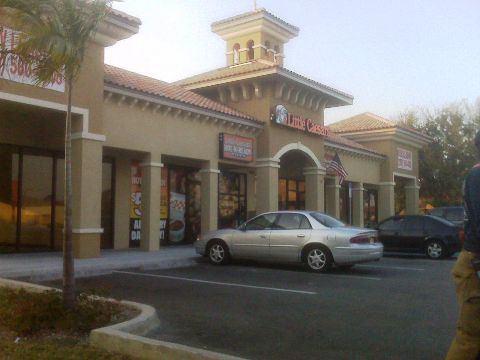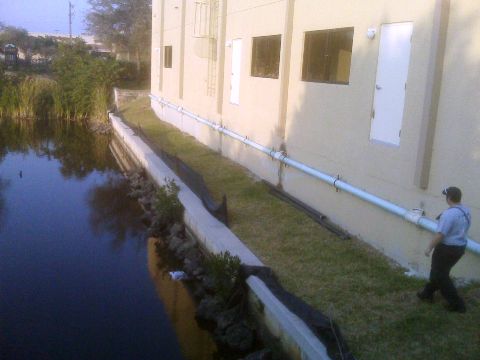
Lieutenant Ken Ossowicz from Cape Coral Fire (FL) Truck 9 found this interesting setup during a preplan. What he found was a pretty typical lightweight multi-unit mercantile building. Not much to discuss from the front, however a view of the “C†side raised some questions.

Lt. Ossowicz thought a call to the prevention bureau was in order. They explained that the original plans called for a wooden staircase to extend from each rear door down to the ground. After approval of the plans, it was later learned that there is a water main running under the strip of grass in the rear of the building preventing them from building the stairs. Since the building occupancy is relatively low and the travel distance from rear to front is small, it did not meet the requirements for a rear egress. So the building owner was told to weld them shut. It’s obviously not an ideal situation, but its better to find this out now prior to a working incident.
19 thoughts on “Canal Access”
Leave a Reply
You must be logged in to post a comment.

If I am reading this correctly, the rear doors are welded shut? Is this the main issue, or is it the large swamp up against the building? I see one door but can’t determine if it is welded shut.
…and they say Venice, Italy has canals! I think the Cape has got them beat. Nice job Lt. Ken and his crew on Truck 9 catching what could definitely present some issues on the Charlie side. My question for Lt. Ken is for water rescues, do you guys respond the Truck or run a Gondola instead??? 😛 Be Safe and rest up, we’re going to need some mutual aid from our Lee County brothers and sisters this summer on our fires…
Lt. John “Johnny” Waligora
City of North Port Truck Co. 84
I’m less concerned with the welded access from the outside than I am with the non-operable door and how it’s presented inside the building.
Seems like they could have run a deck lengthwise and step down on the B or D side.
Are your arial gondolas rear mounts?
Firstly, why would they weld it shut? Could have used those metal stair assemblies that can be moved if they have to get to the water main and still kept them as emerg. exits. glad you guys know about that beforehand.
CJ Doran
Hillsborough County Fire Rescue
Looks like 90 degree “mobile home stairs” would have worked. Nice find guys, way to keep an eye out. It’s amazing what the bldg. dpet. will let some people get away with.
Anybody notice the roof access. By my guess its still a 7′ plus drop from the last rung, and 13′ plus from the bottom of the cage.
Stu,
Our department does not use those access ladders, we use our 24’/35′ extension ladders. And of course if those wont work, we call out the “stick-men” (lol) to get on the roof. (love those guys) Its not in our policies yet but it is in the developing. Goes against the liabilities blah blah. If you absoloutly had to get on that ladder, you could use the roof ladder w/ hooks out and use it like a pompier ladder (hooks over bottom rung) and get up there that way.
I’d not be favorable to welding the door shut. Non-required exits or egress can remain but be clearly marked “NOT AN EXIT” and locked. There is a difference between egress points and marked EXITs. Any door presents us with a host of opportunities and “permanently” locking them reduces our options. Of course this is not always the building dept’s concern, but a door without stairs is likely an insurance issue.
If you look closely, you can see what I think is the weld about half way between the doorknob and the bottom of the door. (Notice the discolored strip.) No close-up pics but looks like it was done from the outside. Maybe think about using a rotory saw with a metal cutting blade. Also notice the hinges are exposed, they would be a easy cut as well. Great place to have one of those “lil giant” ladders!
After reading this post again, I find the part where “the owner was told to weld them shut” very disturbing. Like mentioned above, they could’ve been marked and locked.
As alluded to by RJD above, I wonder how this looks from the inside. Are they visible at all from the interior? Were they originally drawn in the plans as fire exits?
In a fire, any civilians trapped inside and unable to use the front would certainly move towards what would look like a rear door, even if it looked like it was locked.
On the civilian/legal side:
If these were originally fire exits, imagine the liability the property owner is under, even if code enforcement advised them to weld them closed?!?!? An attorney would get everything he asked for with a victim found near a welded door.
The owner ought to remove the door and brick it up and have code enforcement write him an affidavit REQUIRING him to do so.
On the fire side:
If the structure is big enough to have a Little Caeser’s, it obviously has a commercial kitchen. I am guessing they serve hot pizza, even in Florida. So with open flames, gas, and a boatload of cardboard boxes, how can code enforcement NOT require a second exit with that type of fireload/risk? Shoot, the place looks to have at least 3 separate units! What is the occupancy?
Chet
Most doors that have been designed in as EXITs may be discontinued if properly allowed by the AHJ and the Code by removing and EXIT signage. You are allowed to have doors that are not marked exits. The issue would seem to be having a door welded shut without making it very obvious that it was not an EXIT. We typically find, as very well documented here on VES.com, that required rear EXIT doors are quite often improperly locked with non-compliant lock systems.
Hi guys. Yes, these doors are shimmed and welded shut. they look like any other door from the inside. There are no “inoperable” signs or anything like that. Chet, all of your concerns were thought of by me and my crew. I would have thought they should be bricked up as well. I have more pics that show the welds better but they didn’t make it up. Thanks for your comments.
As elluded to by Chet, there is apparently a Little Ceasar’s in the plaza, but these “restaurants” have no open flame. Little Ceasar’s are usually delivery or pick-up only so there is no dining area. The oven is entirely inclosed and it could be gas or electric. In any case I am sure that is how they got around the second exit code for that occupancy.
While I’m not debating Codes, it is good for firefighters to understand what codes apply in their jurisdictions so that they can predict what types of features they’ll encounter.
The point here is that, per the Life Safety Code, a small restaurant with an occupancy under 50, is considered “mercantile” and as such very well may only need one exit, which doesn’t even have to be marked. The type of cooking appliance has no bearing on number of exits (in NFPA 101). The number of occupants, sprinklers and travel distances are the most significant factors affecting the number of exits. A Little Caesars, Dominos, or any fast food shop in a strip mall will likely not be “required” to have two exits.
Great find and just another reason it is so important to learn your first due.
Thank you for sharing and please use this example as a reason to go out and check buildings in your first due.
I by no means have the perfect answer to how to do this, but something I try to do when time permits is to examine buildings on other calls.
When I run an EMS (yuck) call, I look at the building. If it is commerical, I try to do a 360 afterwards looking at doors and other items. I sometimes open lock boxes and check keys (8 out of 10 times I find old non working keys or names for contacts of people who have not worked in 6 years). I check egress, ladder accesibility, etc.. Sometimes things just look like they need more attention, and I use this time to make contacts for a day in the future for a more thourough walk thru of the building.
I often find items that I need to get Fire Loss involved with and see if a code is not being followed or more information like in the case of these doors.
Thank you for sharing your find and keep up the good work on pre-planning.
Stay safe.
~Egan
Good heads up Oz!! Little tuff venting those rear doors.. Better to find out now then at 3 in the morning… You do me proud brother!
gcm
Dude(s),
I got a great story from last night and I had to share it. It involved forcing an interior door from a hallway in a chopped up duplex/apartment building. So anyway, trying to force the door and made about a 6 inch gap at the latch. Long story short, the door would open and it turned out that this door led into a closet in an apartment and was blocked by shelves, etc. Goes to show ya’, ya never know what you’re gonna run in to! I know I was pretty effing surprised!
Hey guys. A lot of you had questions about the presentation of the doors from the inside. This is one of the reasons I decided to send this in. From the inside, the doors present as a useable exit. Lighted exit signs and nothing indicating “not an exit”. We had many concerns about this setup, and high on the list was RIT operations. Even if you COULD get the door open from the inside, you’ve got another surprise coming when you go to crawl out! As far as the welds go, I had better pics of of them (and better interior shots), but in the posted pic, you can see the weld about 18 inches below the doorknob. Every door was like this.